Netta Yerushalmy premieres her Paramodernities at Jacob’s Pillow
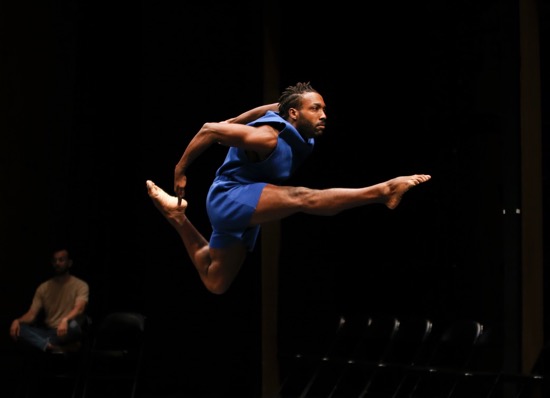
Jeremy “Jae” Neal in Netta Yerushalmy’s Paramodernities #3: Revelations: The Afterlives of Slavery. Photo: Noor Eeman
What? My name listed in the Jacob’s Pillow program among the twenty-four people whom Netta Yerushalmy was gracious enough to thank for the “insights” they contributed to her Paramodernities? Quick search through my e-mail. Yes, in 2013, Yerushalmy (who had been a student in NYU’s Tisch School of the Arts when I was on its faculty) asked me to list what I felt to be iconic dances of the last hundred years. We met and talked. So she began gestating what became her Paramodernities five years ago, during which time she danced with Doug Varone’s company and those of others, set works on university students and professional groups, performed her compositions worldwide, and won numerous grants and fellowships.
At the Pillow, Paramodernities constituted a world premiere, now made up of six sections, divided into two programs. The legendary works to which Yershalmy gradually created what she terms “responses” are Vaslav Nijinsky’s 1913 Le Sacre du Printemps, Martha Graham’s Night Journey (1947), Alvin Ailey’s Revelations (1960), five pieces by Merce Cunningham (1968-1990), Bob Fosse’s Sweet Charity (the 1969 film of it), and George Balanchine’s Agon (1957).
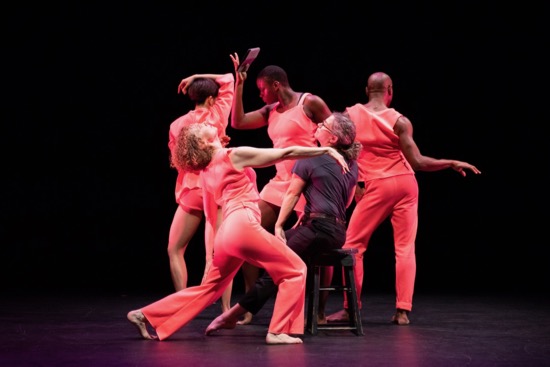
Netta Yerushalmy’s Paramodernities #4: All That Spectacle: Dance on Stage and Screen, a response to Bob Fosse’s Sweet Charity. Center: Julia Foulkes. L to R: Megan Williams, Hsiao Jou Tang, Joyce Edwards, and Michael Blake. Photo: Hayim Heron
Affixed to a noun, the Greek “para” can mean “beside” or “along with” or “against” and more. Although Yerushalmy is inevitably delving into history, she is also—perhaps more collaboratively—dealing with excavation. Imagine opening a grave. In it is a skeleton, muddied, crushed maybe, a few things out of alignment. The archaeologist assembles these, cleans them up, and perhaps displays them. The artist selects certain body parts and ponders them closely; they’ve become material for her. Yerushalmy alludes to the past without attempting to reconstruct it, while also selectively relating it to forces in the culture of its day or to what most interests her about it.
I was, alas, able to see only the program linking the Njinsky, Ailey, and Balanchine works. I use the verb “link” advisedly: These three pieces are titled (in order) The Work of Dance in the Age of Sacred Lives; Revelations: The Afterlives of Slavery; and The Choreography of Rehabilitation: Disability and Race in Balanchine’s Agon. Each has an attendant scholar-commentator onstage or on video—managing audio equipment and projections, and/or enmeshed in the dance.
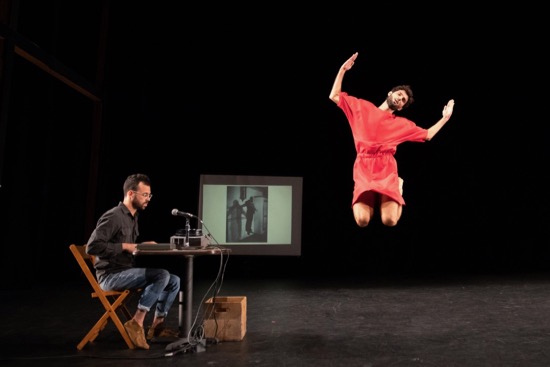
Paramodernities #1: The Work of Dance in the Age of Sacred Lives. Seated: David Kishik; jumping Marc Crousillat. Photo Hayim HeroN
In Nijinsky’s famed Le Sacre du Printemps, a virgin is chosen for a ritual sacrifice to ensure that Spring will come. To Igor Stravinsky’s commissioned score, she dances herself to death. There are only three people in the Doris Duke cast: Yerushalmy, who sits on the floor and watches; Marc Crousillat, who dances; and David Kishik, who sits at a table and feeds cassette tapes into player and projects slides from a carousel (another retro piece of equipment). We hear both Kishik’s occasional comments (he is an Associate Professor of Philosophy at Emerson College) and his recorded text spoken by Michael Cecconi. A few words at the beginning suggest that originally Yerushalmy was to be the dancer, but, because of an injury, couldn’t sustain what amounts to an ordeal.
The text alludes to the philosophers René Descartes and Thomas Hobbes—especially the latter’s Leviathan, a mixture of poetry and philosophy that deals along its way with a nation’s desire for its greatest good and the violence that seethes in nature. Rudolf von Laban, who helped to organize the 1936 Berlin Olympics for Hitler before fleeing his native land, is also mentioned, as is anti-semitism. And (I forget why) the court ballets staged at Versailles at the behest of Catherine de Medici.
If I seem glib in my mention of these, it’s because I can’t take my eyes or my mind off Crousillat. Wearing a short red tunic, he dances. And dances and dances and dances. Those familiar with the film of the Joffrey Ballet performing Millicent Hodson and Kenneth Archer’s reconstruction of Sacre will recognize the elements selected or chosen by chance from the choreography and stitched into a new pattern. Here, for instance, are the trudging, bent-over steps of the elders; the toed-in, quaking stance of the maidens, their cheek resting on the back of one hand; the Chosen One’s bent-kneed jumps, like little screams. The iterations speed up. This time, the dancer’s valiant ordeal ends not in the death of a character, but in Crousillat’s triumph. In the end, when he and Kishik kneel face to face, close together, you can imagine a flow of ideas coursing between them.
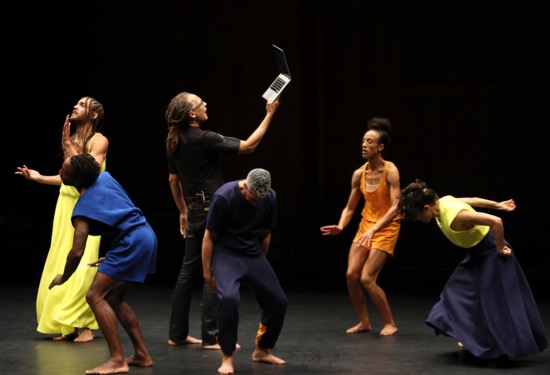
Netta Yerushalmy’s Paramodernities #3: Revelations: The Afterlives of Slavery. L to R: Stanley Gambucci, Jeremy “Jae” Neal. Thomas F. DeFrantz, Nicholas Leichter, Brittany Engel-Adams. and Netta Yerushalmy. Photo Noor Eeman
In Paramodernities #3, the Ailey section, the scholar-speaker never rests. Thomas F. DeFrantz, author of Dancing Many Drums: Excavations in African American Dance, plunges among the dancers, sometimes reading from the tablet he holds up, sometimes speaking fervently. Infected by the motion going on around him, he’s a powerful theatrical presence, speaking of slavery and freedom and American modern dance and the “gay presence” in it—his thoughts often too complex to ponder.
We don’t hear the musical selections that make up Revelations. They informed Ailey’s choreography and surged through the voices of the enslaved. They want to be ready for heaven; they want Jesus to “fix” them, they yearn for their souls to be rocked in the bosom of Abraham. So, in a sense, we “see” the unheard music through what it does to the dancers’ bodies.
Costume designer Magdalena Jarkowiec has avoided Aileyesque costumes, and gender as well as race is contested. For example, tall, slender Stanley Gambucci is garbed in a long, lightweight yellow gown, and Brittany Engel-Adams wears orange shorts and a tank top.
As Jeremy “Jae” Neal, Nicholas Leichter, and Yerushalmy come and go, rarely in unison, they serve up images familiar to Ailey viewers, such as the shaking, shame-on-you finger and fanning gestures of the churchgoing ladies; the leg lifted high to the side; the rhythmic claps; the pleading sit—legs and upper body off the floor in a V—that dominates “I Want to Be Ready.”
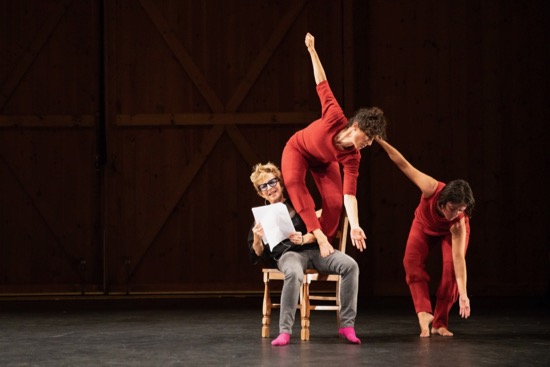
Paramodernities #2: Female Trauma, Interdiction, and Agency in “The House of Pelvic Truth.” Carol Ockman (seated), Netta Yerushalmy, and Taryn Griggs. Photo: Hayim Heron
Because Balanchine drew the steps for Agon from the classical lexicon, in Yerushalmy’s Paramodernities #6, they prod us as if to say, “remember me from The Sleeping Beauty?” Jarkowiec is on pointe part of the time; she wears a white tunic; she’s expert at the lightning-fast footwork that Stravinsky’s score elicited from Balanchine. However, Agon is also full of distortions from ballet’s insistent verticality. Jarkoviec thrusts her pelvis forward, pulls herself in and out of equilibrium, swings her arms.
Yerushalmy has made some provocative choices in dissecting the ballet and titling her response to it The Choreography of Rehabilitation: Disability and Race in Balanchine’s Agon. These issues, along with those of gender and dancing as death’s comrade, link it with the previous two dances, but very lightly. The cast is small—only Jarkowiec, Gerald Casel, and Georgina Kleege appear in the flesh. Mara Mills’s voice is heard, and her image, as well as Yerushalmy’s talking one, is projected onto a white cube. Kleege teaches writing and disability studies at the University of California at Berkeley and has written extensively on blindness. Mills, also an author, co-directs the Center for Disability Studies at New York University.
Two aspects of Agon informed Yerushalmy’s choices. Balanchine created its central pas de deux for the New York City Ballet’s Diana Adams (white) and Arthur Mitchell (black). In 1957, that was a daring move. Like all the dancers in the ballet, she wore a black leotard, he a white t-shirt and black tights. In part because of the nature of a pas de deux in ballet, Mitchell was often in charge, twisting and turning Adams into one subtly discordant position after another, as if he were investigating what this pliable creature was capable of. Yet she challenged him as well. Yerushalmy queries the expected gender roles; Casel is over a foot shorter than Jarkowiec when she’s on pointe. Over and over, hand in hand, they repeat the courtly entrance that in 1957 brought Adams and Mitchell onstage for their duet, but these two face now one direction, now another, as if the audience surrounds them (which it does not).
Yerushalmy devotes much of this Paramodernity to the “death” of a dancer’s career. Balanchine’s wife and muse, Tanaquil LeClercq, contracted polio in Copenhagen during the NYCB’s tour to Europe in November, 1956. She never recovered the use of her legs, although she taught and coached and produced a cookbook of dancers’ favorite recipes. While she was undergoing therapy at a famous sanitarium in Warm Springs, Georgia that treated only wealthy white people, Balanchine and Stravinsky were beginning to devise Agon, whose radical updates of baroque dance forms premiered in December, 1957.
The choreographer and the performers of Paramodernities #6 treat disability obliquely; legs don’t figure in it. Kleege, wielding the slim white cane that signals her compromised eyesight, not only speaks the text to which she contributed, but participates in some of Agon’s redesigned tangles.
While I doubt that everyone seated in the Doris Duke Theater was familiar with dance history, that didn’t seem to matter. All rose and applauded vociferously when these three parts of Paramodernities ended. And I am eager to see, hear, absorb the three sections that I missed when all six are performed at New York Live Arts in Manhattan in mid-March, 2019.

This work sounds madly intellectual, which it obviously is, and extremely complicated and I daresay difficult to see in detail in one viewing. Deborah however has not only accomplished that, she has written so clearly and vividly about what she saw at this concert and over a lifetime of seeing dancing that she makes me want to get to New York in March to see this work for myself.